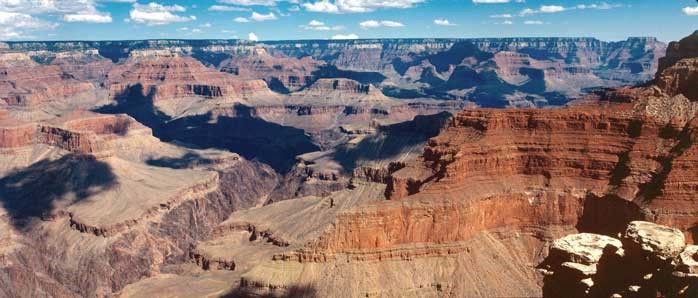
A desert view of the south rim of the Grand Canyon National Park at dawn. The mile-high walls reveal a cross section of Earth's crust going back nearly two billion years. This natural landmark formed about five to six million years ago and erosion from the Colorado River has cut a deep channel through layers of rock.
Source: Credit to National Park Service
| Project Name | Grand Canyon National Park | |
|---|---|---|
| Location | Arizona | |
| Project Sponsor / Borrower | Grand Canyon Conservancy | |
| Program Areas |
|
|
| Value Capture Techniques | Private Contribution | |
| Mode | National Park-Pedestrian / Bicycle / Light Rail Transit | |
| Description |
The Grand Canyon is a mile-deep gorge in northern Arizona. Scientists estimate the canyon may have formed 5 to 6 million years ago when the Colorado River began to cut a channel through layers of rock. Humans have inhabited the area in and around the canyon since the last Ice Age. The first Europeans to reach the Grand Canyon were Spanish explorers in the 1540s. President Benjamin Harrison first protected the Grand Canyon in 1893 as a forest reserve, and it became an official United States National Park in 1919. Located in Arizona, the Grand Canyon National Park encompasses 277 miles (446 km) of the Colorado River and adjacent uplands. Park boundaries extend beyond canyon walls to include 1,904 square miles (1,218,376 acres) of which 94 percent is managed as wilderness. It is particularly important to gateway-community economies including Tusayan, Cameron, Williams, Flagstaff, Jacob Lake, Peach Springs, and Marble Canyon, Arizona, and Kanab and Fredonia, Utah. It also maintains government-to-government consultative relationships with 11 Federally recognized tribes, who consider Grand Canyon their place of origin. Park infrastructure includes 1,600 assets, including over 600 trail miles, 228 road miles, 1,139 lodging units in eight hotels, 544 rim campsites in three campgrounds, and 70 inner canyon campsites in four campgrounds. With five to six million visitors estimated yearly, Grand Canyon provides recreational experiences, including access to a paved-path walk to a moderate hike, a backcountry expedition, or technical river trip. The park also provides a broad spectrum of activities including rafting, hiking, sightseeing, and bicycling. Since 2000, the park has offered year-round shuttle service, with over 7.6 million boardings. |
|
| Cost |
On Feb. 26, 2019 Grand Canyon Conservancy celebrated Founder's Day, the 100th anniversary of Grand Canyon's designation as a national park. FY 2019 Funding
|
|
| Funding Sources |
|
|
| Project Delivery / Contract Method | N/A | |
| Private Partner | N/A | |
| Project Advisors / Consultants | N/A | |
| Lenders | N/A | |
| Duration / Status |
1893 1908: 1919 1975 1979 2019 |
|
| Financial Status/Financial Performance |
Effective June 1, 2018 the park entrance fee will be $35 per vehicle or $30 per motorcycle, for a seven-day pass. An annual park pass will cost $70. In Grand Canyon National Park, 80 percent of entrance fees stay in the park and are devoted to spending that supports the visitor. It shares the other 20 percent of entry fee income with other national parks for their projects. In Fiscal Year 2019, 22 concessioners grossed approximately $182.5 million and paid franchise and other fees of approximately $17.8 million. Income 2019
|
|
| Innovations |
|
|
| Related Links / Articles |
|
|
| Contact | Sally Mayberry Sally_Mayberry@nps.gov |
|